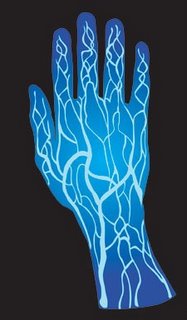Iris Scanning
 Iris scanning can seem very futuristic, but at the heart of the system is a simple CCD digital camera. It uses both visible and near-infrared light to take a clear, high-contrast picture of a person's iris. With near-infrared light, a person's pupil is very black, making it easy for the computer to isolate the pupil and iris.
Iris scanning can seem very futuristic, but at the heart of the system is a simple CCD digital camera. It uses both visible and near-infrared light to take a clear, high-contrast picture of a person's iris. With near-infrared light, a person's pupil is very black, making it easy for the computer to isolate the pupil and iris.When you look into an iris scanner, either the camera focuses automatically or you use a mirror or audible feedback from the system to make sure that you are positioned correctly. Usually, your eye is 3 to 10 inches from the camera. When the camera takes a picture, the computer locates:
- The center of the pupil
- The edge of the pupil
- The edge of the iris
- The eyelids and eyelashes
It then analyzes the patterns in the iris and translates them into a code.
Iris scanners are becoming more common in high-security applications because people's eyes are so unique (the chance of mistaking one iris code for another is 1 in 10 to the 78th power. They also allow more than 200 points of reference for comparison, as opposed to 60 or 70 points in fingerprints.
The iris is a visible but protected structure, and it does not usually change over time, making it ideal for biometric identification. Most of the time, people's eyes also remain unchanged after eye surgery, and blind people can use iris scanners as long as their eyes have irises. Eyeglasses and contact lenses typically do not interfere or cause inaccurate readings.
Vein Geometry
 As with irises and fingerprints, a person's veins are completely unique. Twins don't have identical veins, and a person's veins differ between their left and right sides. Many veins are not visible through the skin, making them extremely difficult to counterfeit or tamper with. Their shape also changes very little as a person ages.
As with irises and fingerprints, a person's veins are completely unique. Twins don't have identical veins, and a person's veins differ between their left and right sides. Many veins are not visible through the skin, making them extremely difficult to counterfeit or tamper with. Their shape also changes very little as a person ages.To use a vein recognition system, you simply place your finger, wrist, palm or the back of your hand on or near the scanner. A camera takes a digital picture using near-infrared light. The hemoglobin in your blood absorbs the light, so veins appear black in the picture. As with all the other biometric types, the software creates a reference template based on the shape and location of the vein structure.
Scanners that analyze vein geometry are completely different from vein scanning tests that happen in hospitals. Vein scans for medical purposes usually use radioactive particles. Biometric security scans, however, just use light that is similar to the light that comes from a remote control. NASA has lots more information on taking pictures with infrared light.
n addition to the potential for invasions of privacy, critics raise several concerns about biometrics, such as:
- Over reliance: The perception that biometric systems are foolproof might lead people to forget about daily, common-sense security practices and to protect the system's data.
- Accessibility: Some systems can't be adapted for certain populations, like elderly people or people with disabilities.
- Interoperability: In emergency situations, agencies using different systems may need to share data, and delays can result if the systems can't communicate with each other.
No comments:
Post a Comment